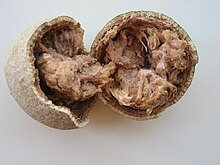Limonia acidissima
| Limonia acidissima | |
|---|---|

| |
| Scientific classification | |
| Kingdom: | |
| (unranked): | |
| (unranked): | |
| (unranked): | |
| Order: | |
| Family: | |
| Subfamily: | |
| Tribe: | |
| Genus: | Limonia |
| Species: | L. acidissima
|
| Binomial name | |
| Limonia acidissima | |
| Synonyms[1][2] | |
| |
Limonia acidissima is the only species within the monotypic genus Limonia. Common names for the species in English include wood-apple and elephant-apple.[3] In India in some regional languages its known as Kavat in Hindi, Kavath in Marathi, kotha in Gujarati, Kaitha/ kaintha in Odia, kabith in Bengali, kaitha in UP/ MP, விளாம்பழம் in Tamil, Kapitthhamu or velagakaya in Telugu, Kapitya (कपित्य) in Sanskrit[4] and so as Divul in Sri Lanka, Kvet in combodia, kawis/kawista in Indonesia (javanese), Kawes in Malaysia.
Description
Limonia acidissima is a large tree growing to 9 metres (30 ft) tall, with rough, spiny bark. The leaves are pinnate, with 5-7 leaflets, each leaflet 25–35 mm long and 10–20 mm broad, with a citrus-scent when crushed. The flowers are white and have five petals. The fruit is a berry 5–9 cm diameter, and may be sweet or sour. It has a very hard rind which can be difficult to crack open, it appears greenish-brown in colour from outside and contains sticky brown pulp and small white seeds. The fruit looks similar in appearance to the Bael fruit (Aegle marmelos). It contains considerable amount of protein, carbohydrate, ferus, fat, calcium, Vit-B & C etc. 100 g of ripe fruit pulp contains up to 49 KCal.
 |
 |
Taxonomy
A number of other species formerly included in the genus are now treated in the related genera Atalantia, Citropsis, Citrus, Glycosmis, Luvunga, Murraya, Microcitrus, Micromelum, Naringi, Pamburus, Pleiospermium, Severinia, Skimmia, Swinglea, and Triphasia.[5]
Distribution
Limonia acidissima is native to India and Sri Lanka.[6] Some sources include Fiji in the native distribution,[7] but Flora Vitiensis nova dates the species' introduction there to around 1880.[6] The species has also been introduced to Indochina and Malesia.[6][7]
Uses
The fruit is used to make a fruit juice with astringent properties and jams. Ripe fruit can be used as "aachar" (smashed with green chilly, sugar and salt only). Another species of this fruits are considered auspicious to be offered to Shiva and Ganesha in pujas. A majority of Hindu temples will have a sacred tree within its compound and is known as the sthala vriksha.
Nutrition
| Nutritional value per 100 g (3.5 oz) | |||||||||||||||||||||||||||||
|---|---|---|---|---|---|---|---|---|---|---|---|---|---|---|---|---|---|---|---|---|---|---|---|---|---|---|---|---|---|
| Energy | 518.816 kJ (124.000 kcal) | ||||||||||||||||||||||||||||
18.1 g | |||||||||||||||||||||||||||||
| Sugars | 0 g | ||||||||||||||||||||||||||||
| Dietary fiber | 5 g | ||||||||||||||||||||||||||||
3.7 g | |||||||||||||||||||||||||||||
7.1 g | |||||||||||||||||||||||||||||
| |||||||||||||||||||||||||||||
| Other constituents | Quantity | ||||||||||||||||||||||||||||
| Water | 64.2 g | ||||||||||||||||||||||||||||
in Fruit Wood Apple
values are for edible portion | |||||||||||||||||||||||||||||
| †Percentages estimated using US recommendations for adults,[8] except for potassium, which is estimated based on expert recommendation from the National Academies.[9] Source: 1 | |||||||||||||||||||||||||||||
References
- ^ "The Plant List: A Working List of All Plant Species". Retrieved 1 August 2015.
- ^ "Arguments for Limonia acidissima L. (Rutaceae) and against Its Rejection as a nomen ambiguum". 27. Taxon. November 1978: 551–552. JSTOR 1219924. Retrieved 2011-04-19.
{{cite journal}}: Cite journal requires|journal=(help); Unknown parameter|authors=ignored (help) - ^ "Limonia acidissima". Germplasm Resources Information Network. Agricultural Research Service, United States Department of Agriculture. Retrieved 2016-04-03.
- ^ http://indiabiodiversity.org/species/show/31505
- ^ John H. Wiersema (2005-02-22). "Species in GRIN for genus". Ars-grin.gov. Retrieved 2011-04-19.
- ^ a b c Smith, Albert C. (1985). Flora Vitiensis nova : a new Flora of Fiji (spermatophytes only). Vol. 3. Lawaii, Hawaii: Pacific Tropical Botanical Garden. pp. 526–527. Retrieved 2018-03-25 – via Biodiversity Heritage Library, digitized by Smithsonian Libraries.
- ^ a b "Limonia acidissima L." Plants of the World Online. Royal Botanic Gardens, Kew. Retrieved 2018-03-25.
- ^ United States Food and Drug Administration (2024). "Daily Value on the Nutrition and Supplement Facts Labels". FDA. Archived from the original on 2024-03-27. Retrieved 2024-03-28.
- ^ National Academies of Sciences, Engineering, and Medicine; Health and Medicine Division; Food and Nutrition Board; Committee to Review the Dietary Reference Intakes for Sodium and Potassium (2019). Oria, Maria; Harrison, Meghan; Stallings, Virginia A. (eds.). Dietary Reference Intakes for Sodium and Potassium. The National Academies Collection: Reports funded by National Institutes of Health. Washington, DC: National Academies Press (US). ISBN 978-0-309-48834-1. PMID 30844154. Archived from the original on 2024-05-09. Retrieved 2024-06-21.
